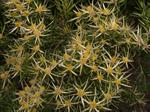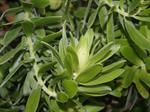 Leucadendrons are closely related to Protea and both are indigenous to southern Africa. There are around 80 species. The genus includes evergreen shrubs and small trees which have green, often waxy, leaves which are arranged in spirals on the stem, dense flower inflorescences, and woody conical seed pods.
Leucadendrons are closely related to Protea and both are indigenous to southern Africa. There are around 80 species. The genus includes evergreen shrubs and small trees which have green, often waxy, leaves which are arranged in spirals on the stem, dense flower inflorescences, and woody conical seed pods.
Leucadendrons are dioecious plants. That is, they male and female plant parts are produced in separate flowers on separate plant species of all species in this genus. Male flowers occur as sessile heads (i.e. no stalk on flowers), on the growth tips. Female flowers are also on the growth tips but are cone-like with woody bracts. The fruit is a nut.
Culture & Propagation
These plants thrive in freely-draining soil. They should be planted in a raised bed if needs be. They also require bright light for at least six hours or more daily.
Plants may be propagated by cuttings or seed. Seed-grown plants can take 3 years or more before they produce flowers. The seeds need warm days and cold nights to germinate.
 Plants of this genus are half-hardy, and are troubled by few serious pest or disease problems apart from root rot.
Plants of this genus are half-hardy, and are troubled by few serious pest or disease problems apart from root rot.
Many cultivars are grown for their colourful foliage and for cut flowers. They may also be grown as a border plant, in a shrubbery, as a windbreak, or as a container plant.
Cultivars/Species:
L. adscendens (syn. L. salignum) – can grow from 30cm to 2m depending on the cultivar, producing a multi-stemmed shrub. Leaves are narrowly lanceolate. They flower for a long period from late autumn through all of winter and spring. The flowers have colourful bracts surrounding the terminal flowers (colours vary from greens and yellows through to tones of orange and red). L. x Silvan Red is a popular cultivar derived from this species which was developed near Melbourne in Australia, and is a valuable cut flower there. Propagate from stem hardwood cuttings, treated with rooting hormone, and placed with 25°C bottom heat and intermittent misting.
L. argenteum - a large bush to small tree. It grows up to 7 to 10 metres tall and has very attractive sessile (stalk-less) grey-green to silver foliage. It has lanceolate leaves covered by fine silvery hairs. The foliage is used in floristry and has a long vase life. It produces large heavy fruits. Plants do well in a sunny position in well-drained soil with protection from frost. They can be relatively short-lived, often dying before 20 years.
L. floridum - to 1.8m tall with yellow flowers, silvery yellow-green foliage. They adapt to acid or alkaline soils but do need the soil to be kept moist during very dry periods. These plants prefer full sun. The fruits can take 6 months to ripen. then within a month they shed the seeds.
L. laureolum (syn. L. decorum) – grows to between 1 and 2m tall. Male plants produce more compact and dense foliage and are rounded in shape. The female plants have more open foliage, and produce green cones. Both male and female plants become bright yellow when flowers form over winter. They prefer a sunny, well-drained position and tolerate poor soils well. They also tolerate acid soils better than some other Proteaceae plants and are able to withstand wind and drought. Do not disturb the roots though!
L. lanigerum (Cone bush) - these have waxy green leaves and cone-shaped seed pods. Plants have a spreading growth habit to 1.8m tall. Male flowers are yellow, and leaves can be tinged with autumn colouration.
L. plumosum (syn. L. rubrum) – the common name is Top Bush, or Tolbos. They occur up to 3,000 feet in altitude in the wild, mostly in sandy soils. Plants may grow to around 2.5m tall. The leaves are around 6cm long and linear to lanceolate in shape. The female flower is most attractive. They produce dried onion-shaped cones which are prized for use in floristry.
L. venosum (syn L. sessile) – these shrubs grow to 1.2metres tall. The leaves are glabrous and an oblanceolate shape to around 10cm long. Flowers commonly have bright yellow bracts and centres - though there is also a less common red flowering form.
More from ACS
Ebook - colourful guide for the enthusiast or commercial grower alike.
View eBook